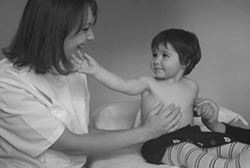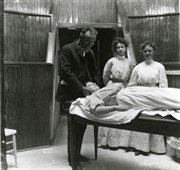Hereford Osteopathic Practice
What is osteopathy?
Osteopathy developed in America towards the end of the 19th century, through the vision of one man, Andrew Taylor Still (1828 - 1917).
Osteopathy focuses on the diagnosis, treatment, rehabilitation and prevention of musculo-skeletal disorders and the effects of these conditions on your general health.
The maintenance of good mechanical function is essential to good health. Problems in the framework (musculo-skeletal system) of the body can disturb the circulatory system or nerves to any part of the body and affect many aspects of health.
It is the osteopath's job to restore the musculo-skeletal system to a state of balance.
When the body is balanced and efficient, just like a well tuned
engine, it will function with the minimum of wear and stress,
leaving more energy for living.
How can osteopathy help you?
We use a variety of approaches to treatment and can bring relief
or improvement to many conditions affecting, for example
infants/children, the elderly, sportsmen and women or to problems
which arise during and after
pregnancy. For a comprehensive list of conditions treated
please see "How we can Help"on our homepage.
Your first appointment
We understand that some people may be a little hesitant about their first visit simply because they may not know what to expect. This is why we allow time to answer questions and discuss any concerns.
It is not necessary to be referred by your doctor although many of our patients are. Your first visit will last 45 minutes. Follow up appointments, if needed, 30-40 minutes. We will want to know how and when your symptoms began and about factors which make them better or worse. Everything you tell us will be dealt with in the strictest confidence.
After a complete medical history is taken you will be given a careful examination, which may include orthopaedic, neurological or circulation tests. You will normally be asked to remove some of your clothing (see FAQs "What Should I Wear") and to perform a series of simple movements so that the mobility of your body can be evaluated. We are trained to examine areas of the body using a highly developed sense of touch calledpalpation, to identify any points of weakness or strain. Once a diagnosis is made we will discuss with you the time scale and type of treatment necessary.
Since we are often the first point of contact for patients seeking relief from a range of conditions, our first duty of care to you, the patient, is to establish whether osteopathic treatment is appropriate. In a small number of cases we may suggest another form of treatment, or that you see your doctor.
Your Treatment

We work with our hands using a wide variety of treatment techniques according to the age of the individual and the nature of the problem. These may include soft tissue 'massage' to muscles, articulation and traction to joints or specific manipulation to improve joint mobility, which may cause a joint to click. Gentle release techniques are often used, particularly when treating children, frail or elderly patients. (See Cranial Osteopathy)
Treatment may include advice on your posture or lifestyle if
these are contributing to your problem. What you do at home,
work, sport or leisure, can greatly affect your progress, and your
part in this treatment is just as important as ours.
Between us we will compile an informal programme for your
recovery.
Cranial Osteopathy
Cranial osteopathy is a refined and subtle type of treatment that uses very gentle manipulative pressure to encourage release of stresses throughout the body, including the head.
Osteopaths vary their treatment methods depending on their own preference and the individual patient's symptoms.
'Cranial osteopathy' is the name by which osteopaths who work at the more gentle, subtle end of the spectrum of treatment have become known.
Please contact us to find out which of our osteopaths have a
special interest in this particular approach.
Osteopathy FAQs
Do I Need to See My G.P. to be Referred to an Osteopath?
No; although many local G.P.s refer patients to the practice it
is not necessary to ask your doctor to refer you.
Will you contact my doctor about my treatment?
We have always worked hard to develop and maintain good communication with local G.P.s. Indeed many local G.P.s and hospital doctors visit 'Kyrle House' for treatment themselves.
We will write to your doctor if there is anything we need to
know that might help us with your care e.g. results of X-rays or
blood tests, or if we think your problem is not related to your
musculo-skeletal system. If your G.P. referred you to the
practice we will write with a summary of our findings and when you
are discharged, to update on your progress.
Can I consult an osteopath on the NHS?
Most osteopaths work in private practice. Unfortunately, NHS provision of osteopathy in Herefordshire is limited to one half day each week within the Musculo-Skeletal Clinic at the Wye Valley NHS Trust HQ. Access to the clinic is via G.P. referral only and waiting times are in the order of eight to ten weeks.
However, as the profession grows and develops stronger links with the NHS, publicly-funded osteopathic services across the UK are gradually becoming more widespread. At Kyrle House we are committed to doing all we can to encourage wider access to osteopathic care in Herefordshire.
What is the difference between Osteopathy and Chiropractic?
This is not an easy question to answer, as it involves some
technical issues. Please follow the link to www.backcare.or.uk (The
Charity for Healthier Backs) for an independent opinion.
Regulation and Safeguards
With the passing of the Osteopath's Act in 1993, osteopathy became the first complementary health care profession to be accorded statutory regulation in the U.K.
The standards of osteopathic training and practice are set, maintained and developed by the General Osteopathic Council (GOsC), the profession's statutory regulator, ensuring that you have the same safeguards as when you visit your doctor or dentist.
To find out more about our training, continuing professional
development (CPD) and osteopathic research, please follow the link
to www.osteopathy.org.uk
Osteopathy links
General Osteopathic Council: www.osteopathy.org.uk
British Osteopathic Council: www.osteopathy.org
